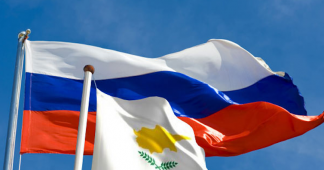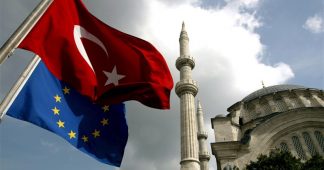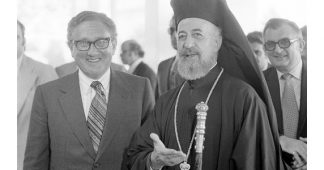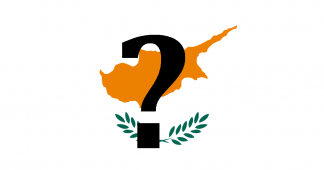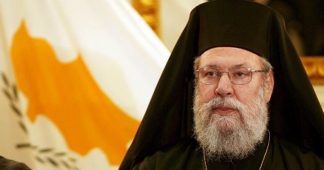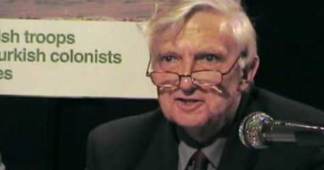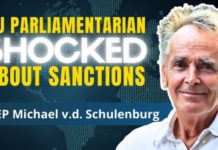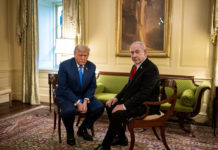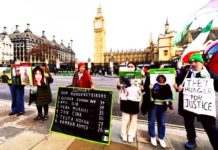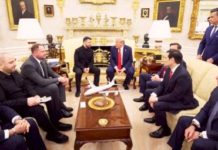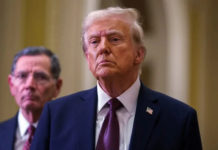An article by Brendan O’Malley
Anyone interested in the recent history of Cyprus and in the role played by foreign powers in the Cyprus problem will find this article very interesting. It is a lecture given recently by Brendan O’Malley to an audience of G/Cs, T/Cs, Greeks and Turks in Boston.
CYPRUS: HISTORY, PRESENT AND THE FUTURE SERIES
Origins of the Cyprus Problem, a lecture by Brendan O’Malley at the Massachusetts Institute of Technology, Cambridge, United States, 16.1.01
Ladies and gentleman, it is a great honour to be asked to come here today to address the first lecture in this series launched by the Cypriot friends of Boston.
The peace movement in Cyprus has already shown what a powerful force young people can be in bringing people together and breaking down barriers to reconciliation and I hope the students of Boston and elsewhere in the United States can emulate their example in winning hearts and changing minds.
So let me begin:
In Britain we have an award they call the Turner prize, named after the famous 19th century painter William Turner, which is meant to go to the best young artist of our time, but many think it actually goes to the one who can provoke the most outrage.
One of its most famous winners is Damien Hirst who made his reputation with a sculpture in two halves, called Mother and Child Divided. It was a cow and calf that died due to complications during pregnancy and birth. To keep things simple I want you to focus on the calf. Picture a calf sliced lengthways down the middle, each side encased and preserved in formaldehyde in a separate glass tank. The two tanks were placed alongside each other so that from one flank or the other, at a particular angle, it looked like a whole dead animal. But in reality the two halves of the calf did not meet — a corridor of space kept the tanks apart and you could walk right down the middle of them.
You can imagine the public reaction. While some art critics thought it sensational, many ordinary people were shocked and appalled by the defilement of an animal’s body, which no doubt was one of the artist’s aims. It seemed to provoke questions about the sanctity of life and our own hypocrisy — for do we not slice up millions of animals daily for our dinner, and in periods of political turmoil do some of us not also butcher our fellow human beings?
For next year’s Turner prize, if the outcome of the Geneva talks is not a successful one, perhaps we should nominate the Green Line on Cyprus. We could argue that is one of the finest functioning conceptual works depicting man’s inhumanity to man and the failure of politicians to lead by statesmanship.
Actually, thinking about it, the line could be the centrepiece of a wider collection from across the island. This could include the ghostly remains of Varosha with 26-year-old washing still hanging on the line, doors left swinging in the wind, after the Greek-Cypriot inhabitants fled invading troops, and perhaps the Museum of Barbarism in Kumsal with gory pictures of Turkish-Cypriot children shot to pieces in 1963 and the actual bloodstained bath in which they tried to hide, where their bodies lay for five days until the press arrived.
And bringing in some more. modem forms, why not include the geodesic domes and pylons of the British strategic spying station at Troodos and the nearbyMount Olympus radar, both blots on the landscape on top of two of Cyprus’s most beautiful mountain tops, yet retained by the former colonial power long after granting independence.
We can include, too, the command and control centre gouged out of the peak below Olympus for the Greek-Cypriot National Guard’s S300 missiles even though the actual missiles have since been assigned to Crete instead; and to complete the set let’s add the vast NATO-standard military airport on the great northern plane at Lefkonico, its long walls and observation posts giving it the air of a prison camp.
What the judges will want to know, of course, is who is the artist who produced this startling collective work. And how could they ensure a such a small country like Cyprus remained bitterly divided in two, giving these works meaning long after the Cold War has ended, when even the Berlin Wall has been turned into souvenir lumps for tourists? Just why is it, they would ask in puzzlement, that Cyprus is still bristling with troops, a trip wire away from a future conflict? Or put more bluntly, as one British military officer said to me last month: “So who is to blame for the Cyprus problem?”
The conventional simplified answer is that it all began in the 1950s when the 80 per cent majority Greek-Cypriot population campaigned to overthrow British rule not to achieve independence but to secure union with Greece. By contrast the Turkish Cypriots — who made up about 18 per cent of the population –preferred the option of partition if the British left. Both diametrically opposed options were banned by the 1960 agreements establishing independence.
You can’t ban aspirations, however, and the new country got off to a bad start. The division of the body politic along communal lines, though designed as a safeguard against dictatorship by the majority, played into the hands of nationalist leaders who, lacking experience of democratic politics or treating independence as a mere stepping stone to another goal, made too little effort to win a consensus between both sides. The consequent deployment by Turkish Cypriots of powers of veto over political decisions created a political crisis which eventually spilled over into fighting on the streets in 1963.
There were brutal killings, intercommunal clashes and gun battles. Turkey sent jets to buzz Nicosia and put naval ships to sea, threatening an invasion; and the Turkish Cypriots pulled out of the system of government. The trouble continued throughout most of 1964 and re-emerged in 1967 when meddling in already roiled waters by Greece and Turkey repeatedly threatened to spark a war between the two NATO allies. With arms from Turkey and support from the Turkish army contingent on Cyprus, many of the Turkish Cypriots retreated into enclaves, a first step towards partition; while Greece smuggled thousands of troops on to the island, strengthening the Greek Cypriots’ hand.
When a military junta took power in Athens in 1967, its leaders discussed with Ankara proposals to get rid of President Makarios by splitting Cyprus in two, but they couldn’t agree on the Turkish demand for two military bases and 10 per cent of territory. An all-out Greek-Cypriot attack on Kophinou drew another threat of invasion by Turkey and brought her once more to the brink of war with Greece.
This forced a humiliating climbdown by the junta, which pulled its 10,000 troops out of Cyprus and concentrated instead on trying to eliminate Makarios. This drove a chasm between pro-enosis and pro-independence Greek-Cypriot parties and led Makarios to rely ever more heavily on the communist movement, AKEL, at home and the Soviet Union internationally. After a series of failed assassination attempts, with Greek Cypriots virtually at civil war with each other, the Junta finally succeeded in staging a coup, though Makarios escaped with his life.
As Britain seemingly took no military action, Turkey ostensibly exercised its right as a guarantor of the 1960 treaty establishing Cyprus to intervene to restore the status quo ante. They had the perfect excuse, personified in Nicos Sampson, the man installed as “President” after the coup. A former EOKA guerrilla, who led assassination squads against the British in the 1950s, in 1964 he had accompanied Dimitrios Ioannides, the future head of the Athens Junta, when he proposed in vain to Makarios a plan to eliminate the Turkish Cypriots.
However, once Turkish troops had landed in Cyprus, Sampson resigned, Makarios’s legitimate deputy (today’s head of state Glafkos Clerides) was installed as temporary president, and Ioannides’s junta collapsed. Yet in a second military operation and the Turks still went on to seize the top third of the island by force, splitting Cyprus in two, as it remains to this day, leaving 200,000 refugees unable to return to their homes. The crisis left 6,000 Greek Cypriots and 900 Turkish Cypriots dead or missing.
The Greek coup and the ensuing Turkish occupation of northern Cyprus sparked international outrage. Congressmen demanded to know why their country, as the main supplier of arms to the two NATO partners had allowed one country to usurp democracy in a friendly state and the other to occupy a major slice of its territory, bringing both of them to the brink of a disastrous war. British MPs cross-examined Foreign Secretary James Callaghan on why Britain, as a guarantor of Cyprus’s independence, with a major air base, numerous spying facilities and thousands of troops on the island, took no military action to prevent the crisis erupting. But Callaghan was evasive and no-one could cut through the shroud of secrecy that descended on the subject. The MPs concluded: “The full truth will never be known unless, and until, all official papers of the period can be seen.”
US Secretary of State Henry Kissinger fought long and hard to prevent key officials releasing documents or answering questions on the period, and in his memoirs Years of Upheaval he was uncharacteristically reticent. He said: “I must leave a full discussion of the Cyprus episode to another occasion.”
It wasn’t until 1999 that he finally returned to the subject in his new book Years of Renewal, under the chapter heading: “Cyprus, a case study in ethnic conflict.” He likened the Cyprus troubles to later wars in Bosnia, Somalia, Rwanda and Chechnya; a blood feud between Greeks and Turks with the Americans as firefighters simply trying to put out the flames before they set light to the whole south-east wing of NATO.
But Kissinger’s account is highly selective. We should remember that he writes not as an objective historian but as a key player in that period of history with his own record to defend.
By painting the situation as a purely ethnic conflict, Kissinger overlooks the paradox that Greece and Turkey, as well as being age-old enemies, are also allies who continuously plotted together with the aim of serving their own interests against the wishes of the Cypriots; and he conveniently avoids addressing the responsiblity that Britain and the United States must bear for contributing to the problem.
Most bizarrely, he makes great play of the need to keep Turkey sweet because of the 26 intelligence and monitoring stations there but neglects to make a single mention of the intelligence bases on Cyprus, to the point that he refers to Britain having two air bases, which wasn’t true in 1974. They had and still have one strategic air base, but two sovereign base areas stacked full of intelligence hardware and a series of sites retained in the Republic of Cyprus for electronic spying and other military installations.
The Americans had a direct interest in these installations because all the information gleaned was shared with Washington under the terms of a secret intelligence pact drawn up in 1947, called the UKUSA agreement. They also benefited from the use of the strategic air base to supply western forces in conflicts in the Middle East — for instance Akrotiri is now used to resupply forces operating the no-fly zone in Iraq and monitor the Camp David Peace agreements between the Arabs and Israelis. Most importantly of all, at the time of the Cyprus crisis the British spying stations were being used to monitor Soviet nuclear missile tests in central Asia.
At the same time there were four US intelligence and communications stations on Cyprus, which the Americans had kept open after independence was granted, without seeking permission from the Cypriot government. According to Laurence Stern these included CIA radio monitors used to eavesdrop on
Middle East and Communist bloc traffic (a role also undertaken by the British facilities). So Cyprus was not and is not a Kosovo, an ethnically disputed region with no intrinsic strategic value other than the negative one of its potential to inflame a wider conflict among important allies in Europe. Cyprus’s problems stem as much from its geostrategic location close to the oilfields of the Middle East and its suitability as a location for monitoring Soviet missile tests and potential Soviet incursions into the region, as they do from the ebb and flow of the Byzantine and Ottoman empires.
Unlike the United States, western Europe was very heavily dependent on that supply of oil, which is why Britain fought long and hard to keep hold of Cyprus. And on this point too, Kissinger got it wrong, the main elements of the 1959 independence agreements were not brokered by London but discreetly by Washington, as British records of NATO meetings and US diplomatic activity show in great detail. And they were shaped not in the interests of giving the Cypriots self-determination, but with the aim of preserving in perpetuity the use of the defence facilities on the island by the West.
It was for similar reasons that for years Britain had waged a deliberate policy in Cyprus of repression and denial of democracy — so that it could continue to use the island to preserve and exploit its position in the Middle East, providing a nuclear bomber base and electronic spying facilities tasked, among other things, on preventing the Soviets taking the oilfields on which the West depended. When Cyprus took over from Suez as the British military headquarters for the entire region in 1955 the policy was simple: Britain could never give up Cyprus and could never let it go communist. Or as British Prime Minister Sir Anthony Eden put it: “No Cyprus, no certain facilities to protect our supply of oil. No oil, unemployment and hunger in Britain. It is as simple as that.”
When the Greek Cypriots rebelled through a political and guerrilla campaign led by Archbishop Makarios and EOKA leader George Grivas, Eden secretly encouraged Turkey to stir up a violent reaction among the island’s Turkish-Cypriot minority and its own population. The aim was to swing international opinion against the Greek Cypriots, who were told that some countries could “never” expect independence. To underline the point, Eden ordered a military crackdown on the island, brought in the death penalty for possessing arms, banned communists and political strikes and sent thousands of troops into the mountains to hunt down Grivas.
Eden’s undoing was the Suez crisis. The ambushes and assassinations by EOKA guerrillas increased and the building of military facilities needed to deter the Arabs and Israelis from war in the Middle East was fatefully delayed by political strikes and bombings — which included most spectacularly the sabotage of the runway at Akrotiri. President Eisenhower urged Eden to compromise with Makarios to eliminate the problems hindering the military use of Cyprus. But before any agreement could be found Nasser nationalised the Suez Canal and Eden plotted behind Eisenhower’s back with France and Israel to launch a military operation from Cyprus and the eastern Mediterranean to prevent what they saw as an attempt by Nasser to unite Arabs and take over the Middle East.
However, because of the problems on Cyprus the operation was delayed disastrously and collapsed under political pressure from the United States. General Sir Charles Keightley, commander of the Suez operation, admitted: “We suffered badly from a shortage of airfields and ports in Cyprus. When operations started both the airfields in use in Cyprus were under construction or repair … our Cyprus bases were dangerously vulnerable to even a single bomber Aircraft had to stand wing-tip to wing-tip, with insufficient dispersal area and the limited port facilities were overcrowded.”
In retaliation against the British, the United States sold sterling, provoking a financial crisis for Eden. Eisenhower then plotted with Harold Macmillan to force Eden out of office in return for Britain pulling out of the Canal Zone. More British troops had died in Cyprus during the crisis than at Suez. But the Government undermined its own envoy’s proposal to offer the Cypriots self-government by secretly encouraging Turkey to demand that if self-determination were offered the Turkish Cypriots must have the right to it too, thus stoking future Turkish demands for a slice of the island through partition.
In reality the British had no intention of giving up Cyprus as long as they needed it. But at a meeting in Bermuda Eisenhower struck a deal: as part of the price of giving Macmillan a nuclear missile deterrent he demanded compromises on Cyprus, starting with the release of Makarios from enforced exile in the Seychelles.
When he came back from Bermuda, Macmillan relaxed the repression on Cyprus and privately looked at ways of retreating from a position of holding sovereignty over the whole island to simply retaining a number of bases on it and handing control over the rest of it to either a NATO mandate or a tridominium of the UK, Greece and Turkey.
British generals were horrified. They feared for the defence of NATO’s southern wing. But Macmillan admitted post-Suez that it would take “more troops than we can afford” to hold Cyprus against the Greek Cypriots’ will over the coming years — a bald, private admission that EOKA and Makarios had won their war.
History records that the independence agreements were concluded after Macmillan tried to force though his proposals for a tridominium; that due to a surprising change of mood in relations between Greece and Turkey a different deal was struck. But British accounts of NATO meetings and diplomatic telegrams reveal that the final agreement was in fact the result of two years of secret behind-the-scenes arm-twisting from the United States. Having bloodied Britain’s nose after Suez, the Americans wanted to find a solution that would preserve the island for use for Western rather than purely British defence purposes and prevent conflict between Greece and Turkey on the issue from damaging NATO.
The result was a system of “guaranteed independence”, an option US officials had first proposed to the British at a private meeting in September 1957 and which Macmillan’s government had opposed all the way down the line. It was no coincidence that in 1959, two weeks after Greece and Turkey finally agreed to the American plan, Washington sanctioned the stationing of intermediate-range ballistic missiles in Turkey and a few months later agreed to supply nuclear weapons to Greece.
The British remained worried that independence might be the worst option for fear of “letting the Russians in”. But Turkish Foreign Minister Fatin Zorlu told them privately not to worry because this was “not really a form of independence”. Note that it was Zorlu relating the details to the British and not the other way around, it was not a British plan.
Britain was left with sovereignty over two military bases and rights verging on sovereignty over numerous military sites within the new Cypriot republic. The island’s territory and constitution was to be guaranteed by the three NATO allies, Britain, Greece and Turkey. The Greek Cypriots would be prevented from taking the island out of the Western sphere of influence or into political union with Greece by a system of vetoes which the Turkish Cypriots could exercise over government decisions. In addition, Greek premier Constantine Karamanlis and Turkish premier Adnan Menderes had struck a secret gentleman’s agreement to press for the new Cypriot state to join NATO and ban the island’s popular communist movement, AKEL.
Within three years the bicommunal system of government established at independence broke down. But the key British and American goal of keeping the Cyprus military and intelligence facilities available for the defence of the West has been upheld to this day.
A contributing factor to the quick constitutional collapse was the fact that the ministers in the new government came to power with no experience of real democracy — because it had been denied them – and many had a history of pursuing the narrow interests of their community through violent or confrontational tactics.
Among the Greek Cypriots, a number of ministers were ex-EOKA men who overcame British rule by the bullet and the bomb, with Athens’ support, and a strong element of the EOKA struggle had involved summary punishment or execution — without a fair trial — of those who dissented or were suspected of betrayal. Turkish-Cypriot leaders also had been continuously encouraged by London and Ankara to make their voice heard through violence. They have admitted for instance that an agent provocateur planted a bomb in their own information centre in June 1958, an act which sparked two months of massacre, riot and arson, prompting Selwyn Lloyd to tell the British cabinet that the Turkish Cypriots appear to be “deliberately creating the impression that it was impossible for the two communities on Cyprus to live together harmoniously”.
When Makarios tried to rewrite the constitution in 1963, apparently encouraged by British high commissioner Sir Arthur Clarke, whose advice he valued, it sparked more bitter intercommunal fighting. The Soviet leader Kruschev offered Makarios his support and there were reports that the Greek Cypriots were importing arms from the Eastern Bloc.
As Turkey privately demanded one or two autonomous areas involving an exchange of population of 35,000 Greek Cypriots and 45,000 Turkish Cypriots, and threatened an invasion; the State Department drew up an astonishing contingency plan to allow Turkey to occupy temporarily a triangle of territory in the north of Cyprus. It was similar to, but bigger than, the area eventually occupied in the first Turkish intervention in 1974, and if necessary an additional enclave was to be occupied in the West at Paphos. Only when Britain requested the UN Security Council to consider sending a peace-keeping force and sent its own command structure to Cyprus in preparation for such a force, did Turkey’s landing ships turn back.
The head of the new command structure, Major General Michael Carver, who became the deputy commander of the UN force when it arrived in March has since admitted that the force was deployed in ways that reinforced the Turkish Cypriot enclaves. These were organised into a civil and military structure with local security decisions made by Turkish-Cypriot TMT fighters, and regional ones by Turkish army colonels under the command of a single Turkish army general. This structure made a Turkish occupation a more practical option.
This policy ran directly counter to that of the UN force’s precursor, the Truce Force sent in after the Christmas 1963 fighting. Its tripartite patrols were led by a British naval lieutenant commander, Martin Packard, who criss-crossed parts of the island working tirelessly on a plan to reintegrate villagers from both sides. He managed to win the support of communal leaders for a plan to use UN troops to escort Turkish Cypriots out of the enclaves into which they had been withdrawing and back into mixed villages.
Currently writing his memoirs of this period, Packard says that the main trouble occurred in the towns influenced by political leaders and those he calls the wild men, individuals on either side who were bent on provocation. Generally in the rural villages, he says, Greek Cypriots and Turkish Cypriots were living peacefully together as they had for generations, though it was often a form of co-existence rather than wholehearted integration. He said in that crucial period there were two ways forward, one was for reconciliation and a unitary state, favoured by international opinion, by moderates and the UN; the other was towards separation and federalism or partition. “That route was favoured by some Turkish extemists and by American and British strategic planners,” he said. “The role played by the military under Carver helped move events towards the separatist route, which led in due course to the 1974 Turkish invasion.”
Ground battles were fought over Kokkina, where Turkey was landing arms, and for control of the Kyrenia-Nicosia road, but sectarian incidents had largely subsided by May 1964, except for the disappearance of 32 Turkish Cypriots in Famagusta after two Greek army officers and a Greek-Cypriot had been shot dead. However, when Makarios announced plans to conscript all 18 to 50-year-olds, Turkey prepared to invade. The invasion was stopped only after
President Johnson sent what acting Secretary of State George Ball described as “the most brutal diplomatic note I have ever seen”. In it he threatened to drop NATO’s guarantee to defend Turkey if their action prompted a Soviet intervention. To back up the note, he moved a naval task force including one carrier, one cruiser and four destroyers into position within reach of Cyprus. Turkish premier Ismet Inonu admitted to the Americans that the key aim of the Turkish military threat was to stop the Packard plan to reintegrate the villages dead in its tracks, and prevent any UN mediation which might force Turkey to give up the progress it had made towards Turkish-Cypriot separatism.
The Americans had pulled back from their plan to allow a controlled invasion, probably because with a UN force in place and without prior Greek agreement it would be politically disastrous. But they immediately sought to find that agreement through diplomatic means.
The immediate signal of this policy was that four days after Johnson stopped the Turks, Packard’s plan, which had gained remarkable support even from military leaders on both sides in Cyprus was axed. Twelve hours before the first Turkish Cypriots were due to go back to their villages with their UN escort, Packard was ordered off the island and sent to Athens on an unmarked CIA transporter plane with only one seat bolted to its fuselage. The same day acting US Secretary of State George Ball flew to Athens and Ankara to begin discussions on a deal to exclude the “Red Priest” Makarios and divide the island between Greece and Turkey.
The British and Americans also acquiesced in the return to the island of exiled General Grivas, with the aim of getting rid of the Archbishop, whose flirtations with the Soviet Union had now convinced even the Greek government that there was a danger of Cyprus going over to the other side in the Cold War. George
Ball had told Packard of his attempts on re-integration: “You’ve got it wrong, son. There’s only one solution to this island, and that’s partition.”
Packard concluded that the maintenance of the sovereign base areas and other military facilities on the island was deemed of paramount importance by the British and American governments, and their advisers certainly thought this aim would more easily be achieved in a divided Cyprus than in a cohesive, military state.
By August US proposals to partition Cyprus between Greece and Turkey were discussed openly at Geneva. When agreement couldn’t be reached, the key architects of these schemes, former Secretary of State Dean Acheson and George Ball devised an astonishing plan to use NATO to force Athens and Ankara to divide the island between them. If the Soviet Union intervened NATO would move in. The high-risk scheme would involve putting the Sixth Fleet between the Greeks and Turks to prevent either of them opposing it. But Johnson refused to give the green light.
In September Acheson and Ball told Johnson over lunch, which was attended by McGeorge Bundy, Kissinger’s dean at Harvard, that they had talked to Turkish generals about a plan to let the Turks occupy the Karpas peninsula, triggering instant enosis by the Greeks “with the consequent supercession of Makarios”. It could be triggered by almost any event, such as the refusal to let Ankara rotate the troops in its 650-strong Cyprus contingent with fresh troops from Turkey. The generals had shown great interest in the plan, which seemed to assume that a resort to action was inevitable. In the previous eight months there had been at least five occasions on which Washington had to stave off major threats of Turkish military intervention in Cyprus and a Greek-Turkish war. The choice, Johnson said, according to Bundy, was “whether it should be messy and destructive or controlled and eventually productive, in accordance with a plan”.
But, wary of the spiralling commitment in Vietnam, Johnson decided against overt intervention in Cyprus, leaving George Ball to reflect wistfully on the days when great powers were ready to use their combined strength ruthlessly, without concern for the rights of sovereignty, the integrity of territory, or the abstract principle, as he called it, of self-determination.
The next critical change for Cyprus came in Greece, where a military Junta seized power, headed by Colonel Papadopoulos, who had been on the paylist of the CIA since 1952. Over the next few years the Greek Colonels’ collaboration with and encouragement of violent opposition to Makarios by those who favoured enosis over independence, eventually moved the island’s majority community into a state of virtual civil war.
From the start, the Nixon administration showed an unhealthy willingness to develop close ties with the dictatorship in Athens. Henry Tasca, the US Ambassador to Athens between 1970 and 1974 testified that in 1968 the junta funnelled funds to Nixon’s election campaign via Tom Pappas, the wealthy Greek-American who had major interests here in Boston. Pappas was later named on the Nixon tapes as one of the first people they asked for cash to pay off the Watergate burglars. Nixon restored arms supplies to the Junta and sealed his condonement of the regime by securing an agreement to home-port the US navy at Piraeus and airforce rights on Crete.
Papadopoulos’s men made repeated attempts to solve the Makarios problem by trying to assassinate him or oust him by force. In several instances the Americans had advanced knowledge of these attempts, in one of them the CIA in Athens seemed to be deeply involved. Paradoxically every time a plot looked like being made public, US diplomats applied pressure to have it stopped. At this point there was a clear dichotomy between covert and public US foreign policy on this issue.
Behind the scenes US officials admitted they would not get satisfaction on Cyprus until Makarios was eliminated from the equation. In 1969 former Acting Secretary of State George Ball was quoted by State Department officials as saying of Makarios: “That son of a bitch will have to be killed before anything happens in Cyprus.”
In 1971 NATO powers once more began secret talks on the future of Cyprus in Lisbon and Paris. US analysts believed a deal for double enosis was on the cards, but it would have to be initiated by Greek action against Makarios because this could be passed off as an internal affair between Greeks, and would stand more chance of avoiding Soviet intervention. A senior Turkish official reported that at the talks Turkey demanded a break-up of the Cypriot state and the Greeks seemed willing to offer a military base.
Following the meeting, Grivas who had been pulled out of Cyprus in 1967, was allowed to return to set up a second EOKA organisation called EOKA-B, dedicated to the overthrow of Makarios and union with Greece. Cypriot officials later told former US Ambassador Taylor Belcher in the strongest terms that there was documentary evidence that the CIA was financing EOKA-B through money passed through the Junta in Athens.
Makarios, on the other hand, sought to bolster his position by making an eight-day visit to Moscow and landing Czech arms to prepare against a possible coup. This prompted more fears in the West that he was becoming a Castro of the Mediterranean who, backed by the strongest communist party in the Middle East, might hand the island to the Eastern Bloc, allowing the Soviets to turn the south-eastern flank of NATO.
There is some evidence to suggest a co-ordinated response by Greece and Turkey. When, in retaliation, Papadopoulos ordered a coup against Makarios in February 1972 the Turks and Turkish Cypriots were informed of the plan in advance, which ties in with the schemes for double-enosis mooted by the
Americans and at NATO. Glafkos Clerides told me that Makarios’s intelligence services first heard of the danger of that coup from decoding messages sent from Turkey to the Turkish Cypriots telling them to store food in their homes and to be on alert.
This time, when Clerides contacted the US embassy, the Americans acted quickly and in Athens Henry Tasca made strong representations to Papadopoulos. Within an hour the message came back that the coup was off. By the end of 1973 Makarios had survived five plots against his life, ranging from attempts to blow him up as he drove past in his car to the shooting down of his helicopter, when he escaped from the wreckage untouched. Papadopoulos by contrast was ousted by Ioannides, a headstrong character whose volatility rapidly proved damaging to American interests. Ioannides, for instance, interfered with US home-porting arrangements in Greece, he let his army — an important part NATO’s chain of defence — run down, and he was constantly spoiling for a fight with Turkey, recklessly handling disputes over oil and sea limits in the Aegean. Washington thought him irrationally anti-Turk to an extreme degree and had to find some way to prevent a disastrous conflict between two NATO! partners, even if it put its own relations with Greece at risk in the short term.
Into this unstable mix add a new Labour government in Britain. It came to power in March 1974 determined to slash defence spending and considering whether to pull out of the Cyprus bases at a time when the West’s spying bases on the island had become critically important. This was only six months after the Conservatives under Edward Heath had refused to let Washington use the Cyprus bases to re-supply Israel in the Yom Kippur war, a refusal which defence sources have said led Kissinger to shut down the intelligence relationship with Britain for a week as punishment, though Kissinger strongly denies this.
Now even the use of the intelligence gleaned by the spying bases seemed at risk. This crisis of trust with Britain came at crucial point in the Cold War. By spring 1974 the Soviets had overtaken the Americans in the numbers of intercontinental nuclear missiles they possessed by 50 per cent and threatened to catch up in the level of missile technology — greater accuracy, the ability to send up a number of independently targetable warheads on one missile and so on. In February and March 1974 alone the Soviets tested four new types of intercontinental missiles with these new capabilities. In April Secretary of State for Defense James Schlesinger admitted that the Americans had monitored
Soviet tests since SALT 1 and discovered Soviet research and development in intercontinental ballistic missiles of astonishing depth and breadth. Missile experts said Moscow was fast closing the technology and deployment advantage that the US enjoyed when it agreed to maintain fewer missiles than the Soviets in the SALT arms limitation agreement in 1972. Kissinger and his colleagues had miscalculated and he now admitted that within a decade the main nuclear deterrent of the West could be vulnerable to wipe-out by a Soviet nuclear attack. In other words the Soviets could win the Cold War. No issue was more important than this, the survival of the Western world was potentially at stake. James Callaghan remembers that when Secretary of State Kissinger first met him after he was appointed foreign secretary that spring the nuclear weapons issue wiped virtually everything else off the agenda. It was the number one issue on Kissinger’s mind.
To keep ahead in the arms race, the Americans had to keep a close eye on medium and long-range nuclear missile tests launched from the Soviet Union’s two main test sites in central Asia at Kapustin Yar and most importantly at Tyuratam, which had 80 operational launchpads. To track these tests they used facilities in Cyprus, Turkey and Iran among others. Information picked up by British spy stations on Cyprus was shared with the Americans under the UKUSA agreement. Cyprus housed some of the most sophisticated equipment needed to monitor the Soviet tests. These included state of the art over-the-horizon radar facilities, which were better placed than facilities in other countries, experts say, because of the need for an over-water propagation path and the island’s ideal distance from the target. The Cyprus facilities were the only ones able to pick up missile signals at the earliest stage of the launch, whereas stations in Iran could pick up the signals from 100 kilometres up! and those in Turkey could normally track them from 400 kilometres up. Kissinger did not once mention these facilities in Cyprus in his accounts. Yet James Callaghan confirmed to me that Cyprus at that time had “extreme value” as a “centre for electronic surveillance of the Soviet Union’s nuclear activity”.
This intelligence capability was the most important reason why Britain needed to keep hold of its Cyprus bases. Yet Callaghan also confirmed that at the time the Cyprus crisis blew up the British were looking to slash their defence budget and as part of this were considering whether to pull out of one or both of their Cyprus bases.
Contrary to Kissinger’s assertion to me that the Americans did not believe this would happen, Callaghan said “high-level” State Department officials repeatedly made representations urging the British not to abandon their bases and intelligence stations. This was a very serious issue for the Americans because under an annex to Cyprus’s 1960 independence agreements, negotiated after the main framework was in place, the Americans could not have taken over the running of the British spying sites in the bases or Cypriot territory if Britain pulled out. Callaghan told me: “The Cold War was hotting up and and there were new Soviet missile test facilities being developed near the Caspian Sea, which we were able to look over. So the Americans didn’t want us to go.” So when Ioannides decided to try to cut Makarios down to size in July 1974, it gave the Americans the opportunity they had been waiting for to split the island.
On at least seven occasions previously, many of them when the Greeks had taken the law into their own hands on Cyprus, Ankara had mobilised for war only to be held back by pressure from Washington. Given these historical precedents, and the history of the United States talking to each side about the plans to carve up the island between them, decisive American pressure on Ioannides not to stage a coup in Nicosia or on Ecevit not to respond with a military intervention was the only way to prevent the division of the island in 1974.
Damning evidence from the CIA and State Department Bureau of Intelligence shows that Washington was repeatedly warned of the junta’s intention to overthrow Makarios and of Turkey’s preparations for a retaliatory invasion, but the State Department failed to act to stop them, as it had in the past, when Tasca forcefully warned Papadopoulos against any heavy stuff in 1972 and Johnson issued his explosive veto to Turkey in 1964. CIA analysts reported that in 1974 “more and clearer warning of the coup against Makarios was given in this case than is usual”. Yet Tasca testified that he was never given any firm evidence and if he had been he would have turned the place upside down to make sure Ioannides got the message. Communications with Ioannides had been conducted not by him but the CIA and he only knew what the CIA chose to tell him. Ioannides himself later claimed that far from dissuading him, the United States had encouraged him to go ahead with the coup.
Members of the US Intelligence Select Committee wanted to know why when Tasca had not been told of the real danger of the coup, the Turks went ahead andmassed troops for an invasion.
Once the coup took place, given the history of Turkish invasion threats the only way to deter an invasion was to reverse the coup or place ships between Cyprus and Turkey. Yet, when Callaghan tried to muster urgent international pressure on the junta to withdraw its officers, Kissinger thwarted him, and the UN Security Council critically delayed meeting for four days, by which time Sampson had consolidated his position and the Turkish paratroops were poised to land on Cyprus.
British prime minister Harold Wilson, by contrast, had taken urgent contingency action against an invasion threat within a day of the coup by ordering a potent naval task force to the area, led by an assault carrier and a destroyer. The British hope was to take joint action with the Americans, along the lines of Johnson’s deterrent in 1964, but that action was effectively vetoed. Callaghan admitted privately that this was the most frightening moment of his career. “We nearly went to war with Turkey,” he said. “But the Americans stopped us.” Tom McNally, Callaghan’s political adviser in 1974, who attended the War Room briefings at which the Navy said they could put a deterrent force in place between Cyprus and Turkey, recalled that “it was made quite clear that Henry Kissinger was not going to get the Americans involved and didn’t think it was a good idea for Britain to get involved either”. The British believed they could provide a deterrent jointly with the Sixth Fleet bu! t without the Americans the British could have had a war in the eastern Mediterranean and lost. Callaghan was convinced that the British task force could have combined with the US Sixth Fleet to deter the Turkish invasion, but he was equally sure that it would be risking a “second Suez” to block the Turks militarily in the face of US opposition.
Dr Kissinger, who was in a uniquely powerful position at the time, as National Security Adviser and Secretary of State, responsible for covert and overt diplomatic activity, strenuously denied that there was any grand design to get rid of Makarios and told me the idea that the US might have encouraged the coup and invasion was “absolute nonsense”. He has also justified US inaction on the grounds that his energies were taken up by the denouement of the Watergate debacle, though he stressed that once the crisis began, he was on top of it.
There is plenty of evidence, if any were needed given the intelligence hardware Britain has on Cyprus and the US has in Turkey, of preparations for both phases of the Turkish invasion. Not least a plan found by the Greek Cypriots on a captured Turkish tank major, it’s contents rushed to Callaghan at the Geneva talks after the first invasion, only for the Greek Cypriots to be told this was nothing more than expected. Or the account from McNally of the warning the British were given from information gleaned by a CIA agent posted to watch the comings and goings of Turkish generals in Ankara. Yet Kissinger also slapped down attempts by Callaghan to threaten military force against Turkey to avert the second, main phase of the invasion.
Curiously, the Americans never discussed with the British arrangements to defend their own intelligence facilities on Cyprus. Callaghan admitted that during the second phase of the invasion the Turks advanced to a line drawn up on maps used by Britain,Turkey and Greece during the Geneva negotiations, that left the major British facilities intact in the south — and the American ones in the north. He also confirmed that the American spying stations continued operating in the occupied area after the crisis — even though the US refused to recognise the Turkish-Cypriot administration.
“The Turks were willing to let the Americans carry on operating because their presence was a political safeguard against the Russians,” Callaghan told me in 1999. If the Americans were operating to a plan similar to those drawn up in 1964, the fly in the ointment was the failure to prevent Congress imposing an arms embargo on Turkey and the failure of the northern administration to gain international recognition to this day. Eventually the Americans persuaded the British to stay in Cyprus too, but they had already ensured that if they left there would still be a NATO stake in the territory of Cyprus where future military facilities could be developed. Lelkonico airport, for instance, having been built to NATO standards, might come in very handy in any global or Middle East conflict.
So to conclude we can see that the architects — or artists — who created this monument to division are many. And there is not one power or community involved in Cyprus — the US, Britain, Turkey, Greece, Greek Cypriots or Turkish Cypriots who have not contributed to or exacerbated what we call the Cyprus problem at some point, or even at many points, in its sorry history. It is interesting to note, however, that the three key goals for which Britain and America strived throughout it all — to secure the future of the military and intelligence facilities on Cyprus for the West, to prevent the island going communist and becoming a Soviet base, and to avoid a conflict that would tear the south-east wing of NATO apart — have been upheld throughout.
Superficially, Cyprus looks no nearer being put back together than Damien Hirst’s cow and calf in formaldehyde. But history does not standstill, the Cold War is long over, the Soviet threat no longer exists, and no other global threat has yet emerged to replace it. And there is a dynamic at work in Cyprus, created by the applications of Cyprus and Turkey to join the EU and by increasing friction between Turkish Cypriots and Ankara.
One lesson from the past is that if you seek a settlement that will involve a peaceful reconciliation of both sides on the island it is most likely to be achievable when the military and economic interests of all parties – Cypriots, Turkey, Greece, Britain and the United States — converge. Membership of the EU for Cyprus and Turkey, alongside Greece, would seem to offer the best hope of that for those three countries. And tactically the process of joining the EU – and the prize to Turkey of economic development — offers the best hope of persuading Ankara to agree to an internationally acceptable solution on Cyprus.
For the United States, where once they had a strategic interest in dividing Cyprus to save the military facilities for the use of the West, they could now see the latter achieved by the convergence of all parties’ defence interests under the aegis of the EU — and perhaps NATO membership for Cyprus too. Greece, Turkey and Cyprus could provide a triangle of stability in an otherwise volatile area.
But another lesson of the past is that you can’t build a united and peaceful Cyprus if you don’t address the emotional triggers that have enabled leaders on both sides to lead their people down either a separatist route or a route to double enosis, and you have to demonstrate statesmanship.
There is a dangerous air of complacency, albeit mixed with exasperation at the tortuous pace of negotiation, among Greek Cypriot leaders, who believe the 2002 deadline for meeting the conditions of the EU entry will force Turkey to reach a critical decision on whether to compromise over Cyprus.
The ambivalent messages emanating from Turkey — such as the reports this month of a secret plan to annex Cyprus and subsequent denials — suggests the government is torn between those who see advantages in meeting the conditions for early entry into the EU, which will involve backing a compromise deal on Cyprus, and those who believe these conditions are unachievable in the near future, especially in respect of relations with the Kurds, democratic freedoms, human rights and the undue political influence of the military.
Greek-Cypriot leaders can help the process by reaching out to the Turkish Cypriots and addressing their fears for their safety and their concern at being swamped politically if the island is reunited. And both sides can help by acknowledging the mistakes, and wrong-doings, of the past — for how can you solve a problem before you admit that it exists?
In the north, demonstrations of political opposition to Rauf Denktash’s hardline on the Cyprus negotiations and to the power of the Turkish army over people’s lives there — under a slogan “Gives us our country back” — are a wake up call to the rest of the world that Turkish Cypriots are not content with the status quo. Without a settlement many fear their community, and with it their identity, will ebb away. The bicommunal peace movement, to which the Cypriot friends of Boston will be a welcome addition, has demonstrated that there is a will for people on both sides to overcome the pain of the past and build a future together.
What better legacy could Glafkos Clerides and Rauf Denktash leave in the twilight of their political careers, than to reunite Cyprus in a way that allows both communities to flourish. But to make that happen they cannot rely exclusively on the efforts of the greater powers, whose priorities do not always coincide with those of the Cypriots. The United States, for instance, may decide to put short or medium-term military alliances and interests above a seemingly more high-risk strategy of seeking long-term peace.
As Tom McNally, Callaghan’s political adviser, remarked of the 1974 crisis: “In the end, the essential military interests of the West remained intact — the intelligence (facilities) and the Turkish membership of NATO — and any other scenario put those in jeopardy.” And Henry Kissinger, when I asked him if he had any misgivings about the way he handled the crisis, said emphatically: “I have no regrets.”
Copyright Brendan O’Malley 2001. All rights reserved
* Brendan O’Malley is foreign editor of The Times Educational Supplement and co-author with Ian Craig of The Cyprus Conspiracy: America, Espionage and the Turkish Invasion (IB Tauris, 1999), which was shortlisted for the 1999 Orwell Prize and was named as a Book of the Year 1999 by the influential British
newspaper The Guardian
